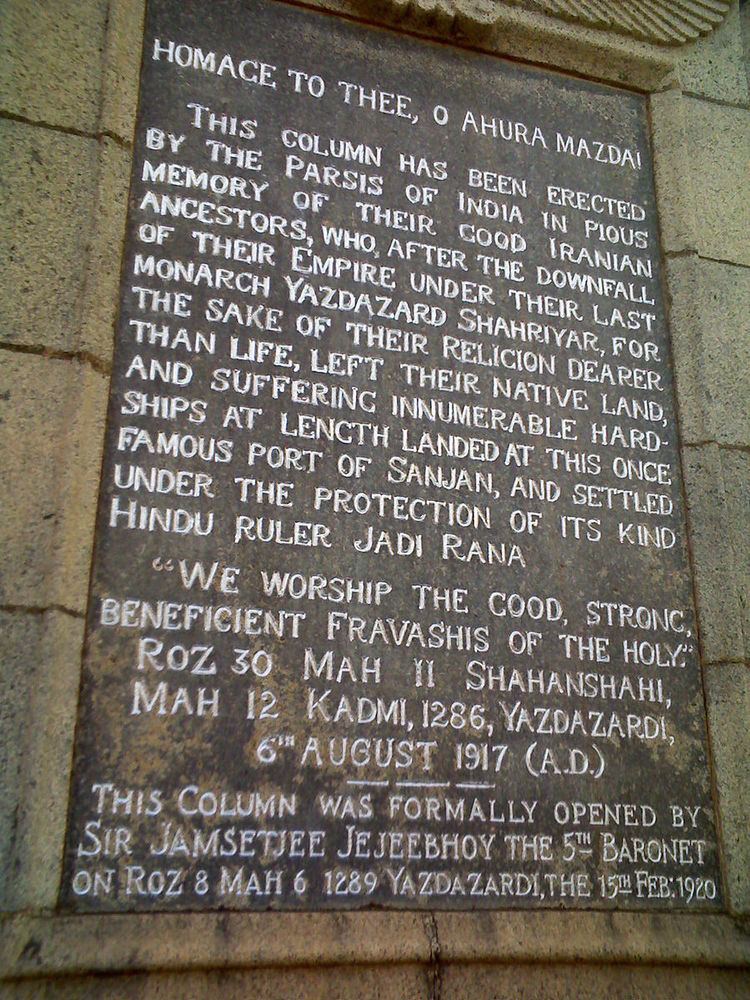 | ||
There have been manifestations of religious liberalism in Rajput courts evident in acts of Rajput rulers who held sway over substantial areas of North India in past centuries, with support for Zoroastrianism, Buddhism and Jainism in addition to various Hindu sects.
Contents
Zoroastrianism
Zoroastrianism, the state religion of Sassanid Persia, was supplanted by Islam following the defeat of Yazdgerd III at the Battle of Nihawand in 642 AD. In due course the lives of non-Muslims became untenable, and many Zoroastrians who continued to adhere to their ancestral faith were forced to emigrate.
According to the Qissa-i Sanjan, an epic poem written about 1600 CE, one group of fleeing Zoroastrians landed in what is now Gujarat, India. They were granted refuge by the local king Jadi Rana, and were allowed to practise their religion freely. These refugees would later found the city of Sanjan in present-day Gujarat.
An even older tradition links the Zoroastrians to India. Many Rajput rulers built temples to the sun god (Mithra (Mihira in Persian). By tradition, only the Maga/Bhojaka priests (originally from Shaka-dvipa in present-day Afghanistan) were entitled to lead worship in these temples. The Maga (called "Magi" in the New Testament) were priests belonging to the Mazdayasni (Zoroastrian) tradition.
Buddhism
Gautama Buddha was born into a Kshatriya (Shakya) family. Buddhism had a significant presence in during the Gupta period (which preceded that of the early Rajput kingdoms), but continued to receive support during the Rajput period.
The Gahadvalas were an early Rajput dynasty who ruled a substantial area in present-day Uttar Pradesh during the 12th century. Gahadvala Govindchandra supported the construction of a large Buddhist vihara at Jetavana. A copper-plate grant of Govindachandra from 1129 mentions the donation of several villages to the Jetavana Mahavihara, the chief of whom was Buddha-Bhattaraka. An inscription (c. 1170) by Gahadvala Jayachandra, located at Bodhgaya, opens with an invocation to Buddha, the Bodhisattvas and the king's preceptor (a monk named Srimitra) and mentions the construction of a cave-monastery at Jayapura. The dikshaguru of Jayachandra was Jaganmitrananda (Mitrayogi), who is considered one of the Mahasiddhas; his book, the Chandra-raja-lekha, has survived in its Tibetan translation.
Numerous other examples of Rajput support for Buddhist institutions exist. Inscriptions documenting the renewal of grants to Buddhist Viharas by the Chandellas of Bundelkhand are one example. The Ajanta caves are Buddhist, and were created in the Rashtrakuta kingdom. The Shilaharas of Kolhapur are also known to have supported both Jainism and Buddhism.
Jainism
All but two of the Jain tirthankaras are ascribed to the Ikshvaku dynasty. Munisuvrata (the 20th) and Neminatha (the 22nd) were from the Harivamsa clan. According to the Jain canon, Rishabhanatha (the first Tirthankara) was the founder of the Ikshvaku dynasty. This dynasty was said to originate with Rishabhanatha who is regarded as the first King on the earth, according to Jain cosmology.
Jainism flourished during Rajput rule. Jains were appointed to high government positions, and Rajput kings supported Jain scholars and institutions. Jain temples ornamenting the landscapes of Rajasthan and Gujarat (including those at Mount Abu, Palitana and Osian) bear testimony to the support extended by Rajput rulers to the Jain tradition.
The Chaulukya ruler Kumarapala was a devout Jain himself and a patron of Jain literary activities. The Rashtrakuta king Amoghavarsha earlier was simialrly a patron of Jainism. The Rashtrakutas of Hathundi were ardent supportes of Jainism,
Arya Samaj
The reformist Arya Samaj movement of Swami Dayananda received significant support from the rulers of Bharatpur, Churu and Udaipur. The text Satyarth Prakash was composed while Swami Dayananda was a guest of the Maharaja of Udaipur.
